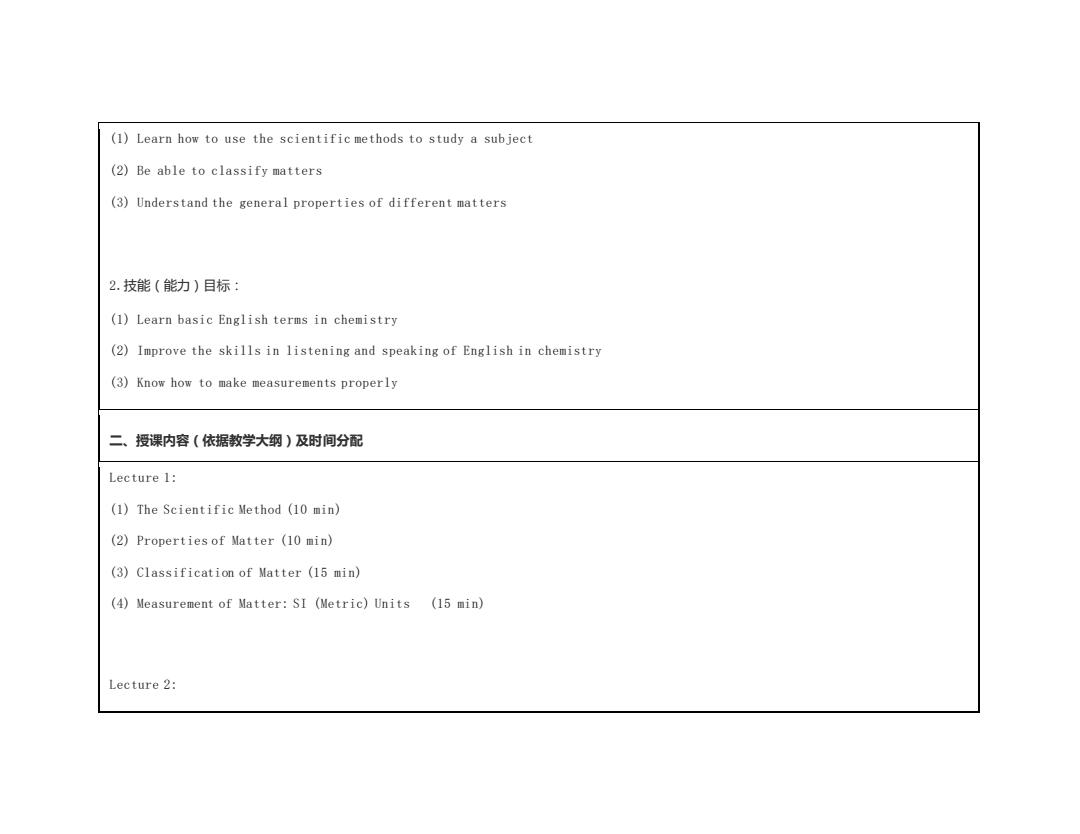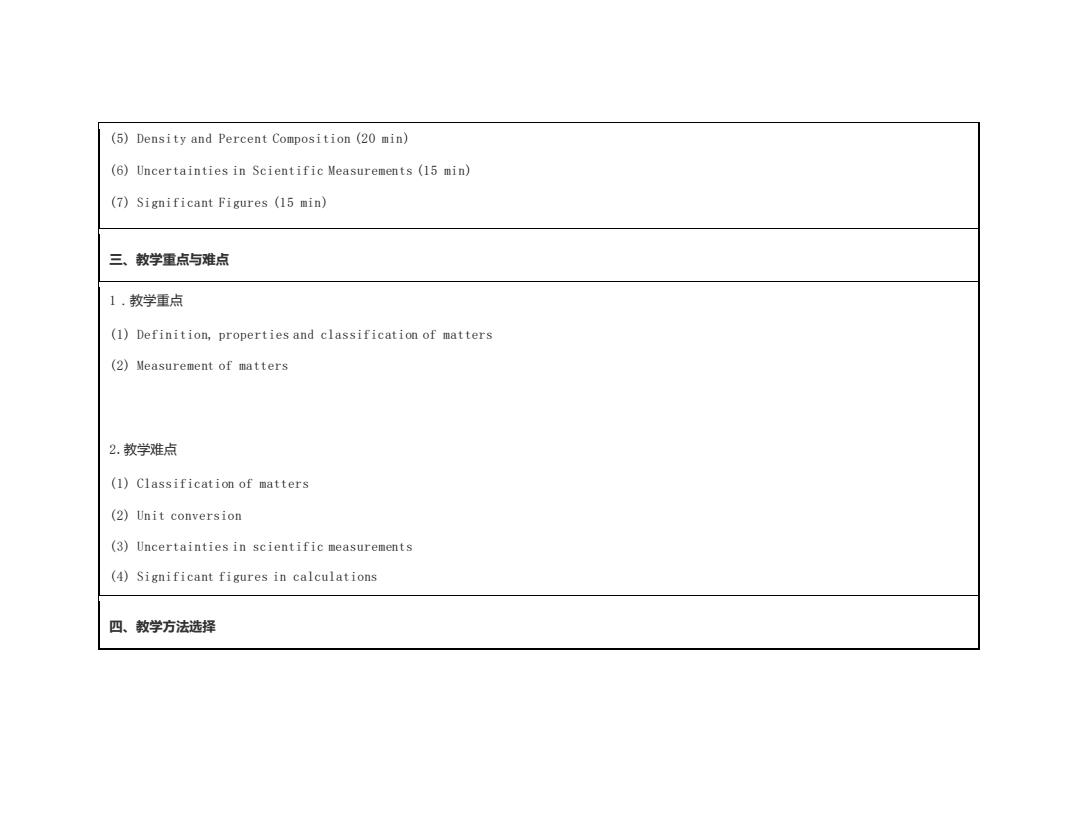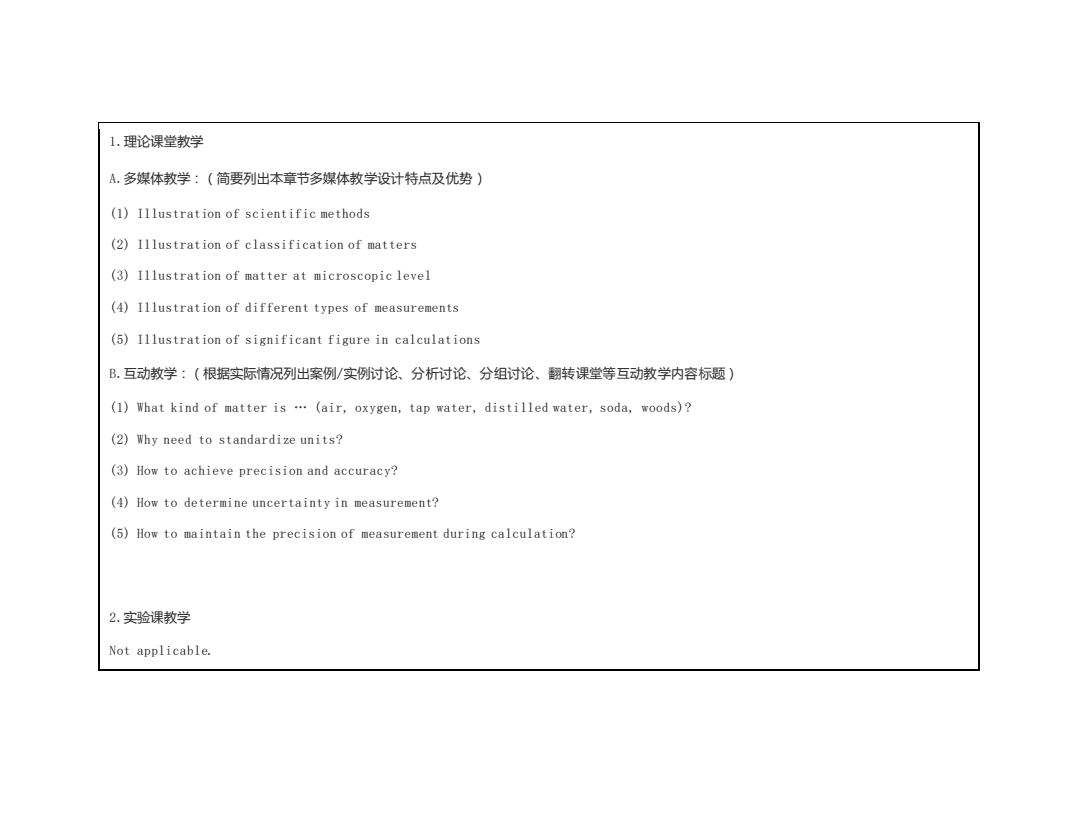
苏州大学医学部药学院 教 案 课程名称: 授课对象: 药学全英班一年级 授课学时: 54
苏州大学医学部药学院 教 案 课程名称: 授课对象: 药学全英班一年级 授课学时: 54

教材版本: General Chemistry:Principles and Modern Applications(10th) 主讲教师: 滕昕辰 苏州大学医学部药学院制 20 年月日 苏州大学医学部药学院授课教案 授课教师:滕昕辰授课日期:2020年10月12日 课程名称 Inorganic Chemistry(英文) 所属学科 药学 教材名称 General Chemistry:Principles and Modern Applications (10th) 授课年级 药学全英文方向一年级 授课章节 1.Matter and measurements 授课时间 100分钟 一、教学目标:含知识目标、技能(能力)目标 1.知识目标:
教材版本: General Chemistry: Principles and Modern Applications (10th) 主讲教师: 滕昕辰 苏州大学医学部药学院制 20 年 月 日 苏州大学医学部药学院授课教案 授课教师:滕昕辰授课日期:2020 年 10 月 12 日 课程名称 Inorganic Chemistry(英文) 所属学科 药学 教材名称 General Chemistry: Principles and Modern Applications (10th) 授课年级 药学全英文方向一年级 授课章节 1. Matter and measurements 授课时间 100 分钟 一、教学目标:含知识目标、技能(能力)目标 1.知识目标:

(1)Learn how to use the scientific methods to study a subject (2)Be able to classify matters (3)Understand the general properties of different matters 2.技能(能力)目标: (1)Learn basic English terms in chemistry (2)Improve the skills in listening and speaking of English in chemistry (3)Know how to make measurements properly 二、授课内容(依据教学大纲)及时间分配 Lecture 1: (1)The Scientific Method (10 min) (2)Properties of Matter (10 min) (3)Classification of Matter (15 min) (4)Measurement of Matter:SI (Metric)Units (15 min) Lecture 2:
(1) Learn how to use the scientific methods to study a subject (2) Be able to classify matters (3) Understand the general properties of different matters 2.技能(能力)目标: (1) Learn basic English terms in chemistry (2) Improve the skills in listening and speaking of English in chemistry (3) Know how to make measurements properly 二、授课内容(依据教学大纲)及时间分配 Lecture 1: (1) The Scientific Method (10 min) (2) Properties of Matter (10 min) (3) Classification of Matter (15 min) (4) Measurement of Matter: SI (Metric) Units (15 min) Lecture 2:

(5)Density and Percent Composition(20 min) (6)Uncertainties in Scientific Measurements(15 min) (7)Significant Figures (15 min) 三、教学重点与难点 1.教学重点 (1)Definition,properties and classification of matters (2)Measurement of matters 2.教学难点 (1)Classification of matters (2)Unit conversion (3)Uncertainties in scientific measurements (4)Significant figures in calculations 四、教学方法选择
(5) Density and Percent Composition (20 min) (6) Uncertainties in Scientific Measurements (15 min) (7) Significant Figures (15 min) 三、教学重点与难点 1.教学重点 (1) Definition, properties and classification of matters (2) Measurement of matters 2.教学难点 (1) Classification of matters (2) Unit conversion (3) Uncertainties in scientific measurements (4) Significant figures in calculations 四、教学方法选择

1.理论课堂教学 A.多媒体教学:(简要列出本章节多媒体教学设计特点及优势) (1)Illustration of scientific methods (2)Illustration of classification of matters (3)Illustration of matter at microscopic level (4)Illustration of different types of measurements (5)Illustration of significant figure in calculations B.互动教学:(根据实际情况列出案例/实例时论、分析讨论、分组讨论、翻转课堂等互动教学内容标题) (1)What kind of matter is .(air,oxygen,tap water,distilled water,soda,woods)? (2)Why need to standardize units? (3)How to achieve precision and accuracy? (4)How to determine uncertainty in measurement? (5)How to maintain the precision of measurement during calculation? 2.实验课教学 Not applicable
1.理论课堂教学 A.多媒体教学:(简要列出本章节多媒体教学设计特点及优势) (1) Illustration of scientific methods (2) Illustration of classification of matters (3) Illustration of matter at microscopic level (4) Illustration of different types of measurements (5) Illustration of significant figure in calculations B.互动教学:(根据实际情况列出案例/实例讨论、分析讨论、分组讨论、翻转课堂等互动教学内容标题) (1) What kind of matter is … (air, oxygen, tap water, distilled water, soda, woods)? (2) Why need to standardize units? (3) How to achieve precision and accuracy? (4) How to determine uncertainty in measurement? (5) How to maintain the precision of measurement during calculation? 2.实验课教学 Not applicable